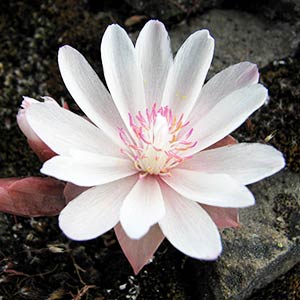Lewisia rediviva
Lewisia oppositifolia
bitter root, bitterroot lewisia, resurrection flower
opposite-leaf lewisia
gradually ramified distally.
gradually ramified distally.
procumbent to erect, 1–3 cm.
erect, basal nodes underground, 10–20(–25) cm.
basal leaves withering at or soon after anthesis, sessile, blade linear to clavate, subterete or grooved adaxially, 0.5–5 cm, margins entire, apex obtuse to subacute;
cauline leaves absent.
basal leaves withering at or soon after anthesis, abruptly narrowed into broad petiole, blade linear-spatulate to linear-oblanceolate, flattened, 4–11 cm, margins entire, apex obtuse to subacute;
cauline leaves opposite, in 1–3 pairs near stem base, smaller than and similar to basal leaves.
with flowers borne singly;
bracts 4–7(–8), whorled, subulate to linear-lanceolate, 4–10 mm, margins entire, apex acuminate.
racemose to subumbellate cymes, (1–)2–5(–6)-flowered;
bracts alternate proximally, 1–many at each flowering node distally, lanceolate, 4–8 mm, margins entire or toothed at apex, apex acute to acuminate.
pedicellate, disarticulate in fruit;
sepals (4–)6–9, broadly elliptic to ovate, 10–25 mm, scarious after anthesis, margins entire to somewhat erose, apex obtuse to rounded;
petals 10–19, usually rose to pink, sometimes lavender, sometimes with paler or white centers, or wholly white, elliptic, oblong, or narrowly oblanceolate, 15–35 mm;
stamens 20–50;
stigmas 4–9;
pedicel (1–)3–15(–30) mm.
pedicellate, not disarticulate in fruit;
sepals 2, suborbiculate, 4–8(–10) mm, herbaceous at anthesis, margins coarsely toothed but not glandular, apex obtuse to rounded;
petals 8–11, pink fading to white, oblanceolate to obovate, 9–15 mm;
stamens 8–18;
stigmas 3–5;
pedicel 20–75 mm.
5–6 mm.
5–6 mm.
6–25, 2–2.5 mm, shiny, minutely papillate.
5–15, 1–1.8 mm, shiny, smooth.
= 26, 28.
Lewisia rediviva
Lewisia oppositifolia
Varieties 2 (2 in the flora).
Native Americans commonly ate the boiled roots of Lewisia rediviva.
(Discussion copyrighted by Flora of North America; reprinted with permission.)
Lewisia oppositifolia is known only from Del Norte County, California, and Josephine County, Oregon.
The floral symmetry of Lewisia oppositifolia may be somewhat elliptical, the outer two petals alternating with the sepals and the remaining petals imbricate and opposite the sepals, giving the flowers a pinched appearance, a feature also reported for L. nevadensis. The more diminutive, higher-elevation plants of L. oppositifolia possibly represent a distinct taxon that has been informally recognized as “Lewisia richeyi” (B. Mathew 1989b).
(Discussion copyrighted by Flora of North America; reprinted with permission.)
1. Basal leaf blades clavate to narrowly oblanceolate, grooved adaxially; sepals 10-12(-15) mm; petals 15mm; stamens 20-30 | var. minor |
1. Basal leaf blades linear, subterete, not grooved adaxially; sepals 15-25 mm; petals 18-35 mm; stamens 30-50 | var. rediviva |
- Local floras:
BC,
CA,
OR,
WA
- Local Web sites:
CalFlora,
CalPhotos,
Flora NW,
PNW Herbaria,
Turner Photog.
WildflowerSearch
iNaturalist (observations)
USDA Plants Database
- LBJ Wildflower Center
- SEINet
- Plants of the World Online
- Encyclopedia of Life
- Wikipedia
- Google Image Search


